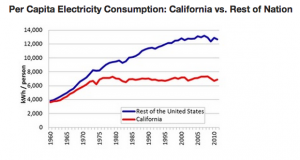Will Cuts to the EPA Diminish the Sustainability Movement?
With recent threats of a 31% budget cut to the EPA, many of my colleagues have been asking me how I think these policy changes are going to affect the sustainability movement and the planet as a whole. I understand that these changes will directly affect many beneficial programs and private companies that rely heavily on EPA funding. Though the reality is that things aren’t just going to fall apart and turn back fifty years overnight, we’re going to have to adapt. We are a resilient species and the majority of us realize there is a lot at stake here. There is no denying that the white house’s position on the environment and many other issues for that matter, are not in the direction most of us want things to go. But, with all the chaos currently happening, it is bringing to light a lot which we’ve been lacking on. For years we’ve sat back and expected the government to do most of the work, but in light of these recent changes, it’s becoming increasingly clear that in order to make real change, we need to step up and do the heavy lifting ourselves.
While some are set on the doom and gloom of it all, (thinking that this is the end to all environmental protection and carbon reduction programs) there is a lot more happening that isn’t front-page news. Many are worried that with major cuts to the EPA, losing programs like Energy Star and environmental clean up initiatives, will be the end of environmental protection and climate change progress, as we know it, and perhaps it is. It’s easy to think that with this impending loss of the EPA headed our way, perhaps the sustainability movement and environmental conservation is on it’s way out entirely. The truth is, that this negative pressure from the federal government, will actually push us towards greater innovation in the commercial industry as well as force states to create new and perhaps more effective programs. This isn’t to say that cuts to the EPA are a good thing, just that we’re going to adapt and do what is necessary to fill in the gaps and continue the progress.
Initially the transition may prove difficult and re-adjusting could take some time. The current EPA plan looks to lay “off 25% of its employees and eliminate 56 programs including pesticide safety, water runoff control and environmental cooperation with Mexico and Canada under NAFTA.”[1] If and when these changes to the EPA take place, it would be a significant setback for conservation and sustainability initiatives, and it will require a transition period to re-establish programs in their new form.
So, what can be done to push things forward while so much seems to be moving in giant leaps backwards? Where the initial push for carbon reduction and energy efficiency came from EPA programs, the next phase of sustainability is going to have to be lead by industry leaders in the commercial markets, states and local governments. The fact is, the ball of sustainability has far too much momentum at this point to be turned around. Look at Tesla, for instance investors are starting to see the potential in electric vehicles and renewable energy and when people are making money, innovation in these technologies will only increase. Another point to note, is that in recent years, many companies have hired Corporate Sustainability Officers and created Sustainability Action Plans and Annual Sustainability Reports to directly address climate change, reduce energy costs as well as track and set limits on the company’s carbon footprint. States are stepping up as well, as many are upgrading energy codes to the more stringent standards and local towns are setting policies on pesticide use, plastic bag use and energy efficient building codes.
The general consensus is clear. Climate Change is happening and we need to take whatever steps we can to reduce carbon and free ourselves of fossil fuel use. Corporations, developers, financiers, local and state governments will now need to stand up and continue the progress forward. These changes to the federal budget can be seen as “the forced passing of the torch” that spur the next rise in sustainability leaders across all industries. As consumers, employees and corporations come to expect energy efficiency, LEED Certified buildings, organic products and environmentally preferable as the norm, businesses adept in sustainability will emerge as industry leaders in the years to come. The success of the initial sustainability leaders will indicate to others across all industries that pushing for sustainable products and services is not only a smart decision for people and the planet, but also a wise financial decision.
Look at just some of the changes happening in the last few years:
Poll: Energy Efficiency is America’s No.1 Housing Concern
How big companies are reducing emissions-and making money
California Is Proof That Energy Efficiency Works
Other States are updating energy codes for significant savings in both energy costs and carbon:
- “Energy cost savings for New York resulting from the state updating its commercial and residential building energy codes … are significant, estimated to be on the order of nearly $250 million annually by 2030.”[2]
- “Energy cost savings for Massachusetts resulting from the state updating its commercial and residential building energy codes … are significant, estimated to be on the order of nearly $144 million annually by 2030.”[3]
As seen in the graph below, California has long been a leader in energy efficiency and continues to rely heavily on state funding to push these initiatives forward.
In closing, we are at the point of a many make or break moments. The protests at Standing Rock are a clear indicator of what we are up against and what we need to do to push forward to protect this great planet. We have the ability to change the world for future generations, either for the better, or for the worse. It is up to us. It is clear we can’t rely on government to do the work for us and we need to each do our part. With the right focus, we can continue the momentum forward and push to make the necessary changes for a better tomorrow.
Things you can do right now to help the cause:
- Call your city and state representatives and voice your opinion on the issues. I recently called my reps and I actually spoke with someone in the office, your voice counts. What policies could be created to improve local programs?
- Vote with your dollars. When you make purchases think about what environmental impact you are making and how you might be able to purchase a more sustainable product or service.
- Get Active: Get out and speak to others in your community and at work about environmental protection and sustainability. What can you do at home or in the office to improve?
- Be Aware: What is going on locally? What environmental programs does your state already have? Where are things lacking?
- Sign your name: Here: This letter supports Energy Star, Water Sense & Safer Choice programs run by the EPA.

